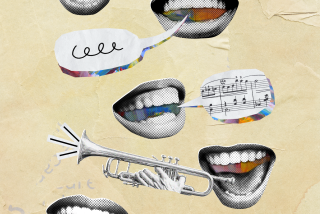Street Kids Discover New Life in Music
CARACAS, Venezuela — Gathering backstage, the symphonic orchestra is the usual preconcert cacophony of instruments being tuned. But there’s an added clamor here: the yammering in street slang and the roughhousing.
One musician has a 39-stitch scar across his face from a gang fight. Another lived in an abandoned car for a year when he was an 8-year-old runaway.
They belong to what organizers say is the only symphony in Latin America made up of former street kids, gang members, drug users and abused children.
Dressed in freshly laundered white shirts, the youngsters file calmly into the performance hall and launch into surprisingly respectable renditions of Marc-Antoine Charpentier’s “Te Deum” and “Hallelujah” from Handel’s “Messiah.”
The audience bursts into applause.
“It’s absolutely moving,” says Xiomara Jimenez, a museum director whose eyes fill with tears.
The experience is moving for the musicians too. For many of the children, classical music has become an escape from their emotional pain.
Still, organizers acknowledge the orchestra alone won’t solve the young people’s problems.
Its director, Manuel Mijares, has to cancel practice occasionally because some children are too angry, depressed or distracted to concentrate. Daniel, 14, the boy who lived in the car, punched out a window at school during a fight recently and needed four stitches in his hand.
The orchestra is the brainchild of directors of an acclaimed program in which symphony musicians are hired to teach children to play classical music. Launched in 1975, the National System of Children’s Orchestras has formed 162 orchestras throughout the South American nation with donated instruments and money from government grants and private donations.
Last year, organizers decided to take on a special challenge: creating a symphony in a facility that houses some of Venezuela’s most troubled and abused children, the Gustavo H. Machado Center in eastern Caracas.
The goal is to build the children’s self-esteem and keep them away from drugs and crime.
Until 1995, the state-run center was a neglected horror, its walls crumbling and disease rampant among the children. Then a nonprofit group took over and turned it into a model project. But even with that success, forming an orchestra at the center was seen as “almost impossible,” says Nancy Carreno, the orchestra’s coordinator.
Workers at the center sent Mijares, a 32-year-old cellist with Caracas’ prestigious Simon Bolivar Orchestra, some of their toughest youngsters. Almost all had been traumatized by life on the streets or by parents who beat or abandoned them.
To the staff’s surprise, the children were captivated by the violins, trumpets and cellos. “Music was a discovery for them,” says the center’s director, Ninoska Zambrano. “They feel important; they feel valuable.”
They gave their first concert just two months after starting.
“It was a miracle,” says Mijares.
The music teachers must double as counselors and social workers, listening to the children’s concerns and supporting them in times of crisis. Many of the orchestra players have a long way to go before overcoming their traumas.
Raiza, 14, says she often takes her violin into a room to play alone and cry. “I love music,” she says, though it also “makes me sad.”
In the last year, the orchestra has gone on two tours around Venezuela and given a dozen concerts, including a performance before President Hugo Chavez in the nation’s premier theater, the Teresa Carreno.
The orchestra has become the pride of the Machado center, where the musicians are often envied by the two-thirds of the center’s youngsters who are not in the orchestra, either because they didn’t try out or they didn’t qualify.
The orchestra’s 52 boys and girls, who range in age from 9 to 17, practice four hours every morning and spend the afternoon studying math, science and English.
Mijares says they play well--”They’re sensational with rhythm”--and a few could even become professionals. All the youngsters have learned to read music.
For some, the orchestra seems to have genuinely turned their lives around.
Lenna, 17, the former gang member whose face is scarred, is back in school studying carpentry and living with his family.
“I used to think about guns and robbing people,” he says. “Now I feel like I’m progressing.”
These days, his most prized possession isn’t a pistol but a gift from a center volunteer: his own clarinet.
More to Read
The biggest entertainment stories
Get our big stories about Hollywood, film, television, music, arts, culture and more right in your inbox as soon as they publish.
You may occasionally receive promotional content from the Los Angeles Times.










